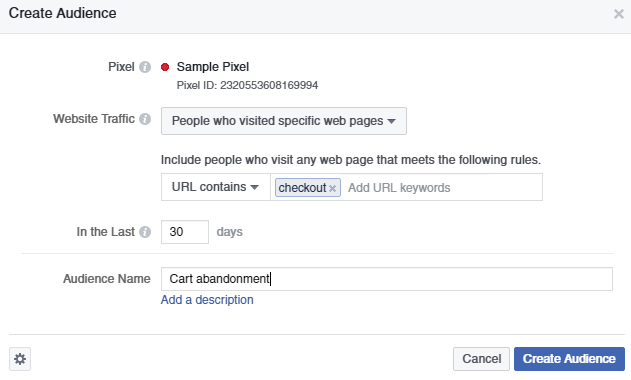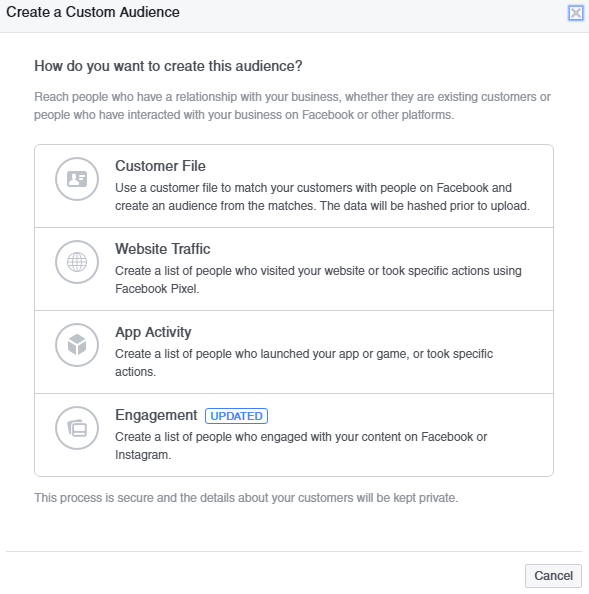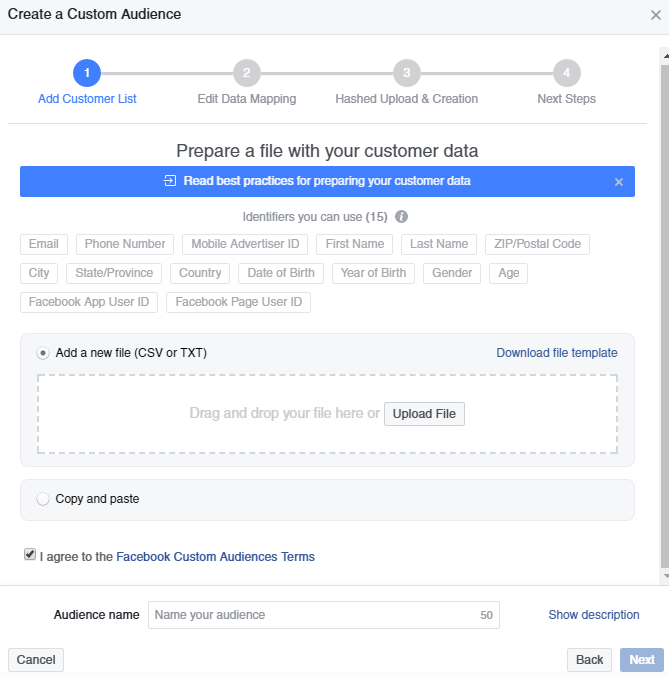A quick & comprehensive guide to Facebook remarketing

Struggling with conversions and the ever-growing cart abandonment epidemic?
You’re not alone. The attention span of the average visitor on-site is shrinking. Meanwhile, cart abandonment rates are on the rise as more visitors drop off for one reason or another.
In fact, research from Listrak puts the average abandonment rate at approximately 75%.

Yikes.
These factors combined spell double trouble for marketers who just can’t seem to convert visitors despite their best efforts. And you can do just about everything right in terms of conversion optimization and still watch your would-be customers or opt-in’s slip away.
Maybe they had second thoughts about your price point or something in your copy rubbed them the wrong way. Perhaps they had to step away from their screen and flat out forgot to come back.
Either way, it happens.
That’s why Facebook remarketing has become the bread and butter of marketers looking to win back lost traffic.
For starters, Facebook ads allow marketers to get hyper-specific in terms of their audiences and who they’re targeting. Also consider that the average person is spending nearly an hour per day on Facebook, increasing the likelihood of eyeballs on your ads versus the blind hope that your past visitors will return on a whim.

In this guide, we’ll cover some of the essentials of Facebook remarketing, including:
- What Facebook remarketing is (and what it isn’t)
- How Custom Audiences and Facebook Pixel work
- The in’s and out’s of generating Custom Audience and Facebook Pixels
- Why Facebook remarketing excels above the majority of social ads
Whether you’re new to the world of Facebook remarketing or want to fine-tune your next campaign, this guide can set you on the right path.
So, let’s get into the nitty gritty.
What is Facebook Remarketing?
Facebook remarketing refers to the act running ads targeted toward past visitors to your site.
Let’s say you run an ecommerce store. You’re getting traffic to your checkout pages, but your bounce rate on those pages is pretty high. You realize that people are right on the edge of converting but you’re losing them.
Through Facebook’s tracking pixel, you can identify visitors who bounced and run a targeted ad based on their behavior. For example, you could offer a Facebook-exclusive coupon code or some sort of freebie to incentivize them to complete their purchase.
Here’s an example of an ad from Jon Loomer directed at someone interested in purchasing one of his digital courses:

The copy in this particular ad is specifically served for traffic who was on the fence about Jon’s course and needs some reassurance. This is obviously much more likely to convert a previous visitor than a generic, one-size-fits-all ad.
In short, the biggest benefits to running a remarketing campaign are three-fold:
- Your ads are front and center in your leads’ Facebook feed: in other words, they occupy prime real estate.
- Facebook remarketing isn’t impacted by ad blockers which are crippling most native ads these days.
- Marketers have so much information at their fingertips through Facebook ads that they target exactly who they want.
Now, it’s also important to note what Facebook remarketing is not.
Despite popular belief, remarketing isn’t about “stalking” your traffic or hunting them down. Remarketing isn’t a silver bullet solution, either. If you want your campaigns to succeed, you’re going to need to know exactly who to target.
Speaking of which, effective targeting starts with understanding how Custom Audiences and Facebook Pixels work.

Breaking Down Custom Audiences & Facebook Pixels
The beauty of Facebook ads is that you can break down your ad-targeting based on extremely specific behaviors and the backgrounds of your leads.
Your current customer list via email? Check.
Traffic that visited a particular page? Check.
Visitors that haven’t hit up your site in a while? Check.
First thing’s first. You need to create your Custom Audience based on who you’re targeting. In Facebook’s own words, the purpose of a Custom Audience is to “connect with people who have already known interest in your business or product.”
So here’s what we see when we start to figure out our audience:

As you can see, we have a few options. For example, if we select “Customer File,” we have the option to either import a customer list via MailChimp or prepare a file of our own customer data:

You can see just how in-depth Facebook remarketing gets at a glance, right?
Well, for the purposes of this guide we’re going to focus on Website Traffic. After all, that’s where the Facebook Pixel comes in handy.
Think of a Facebook Pixel as a sort of tracking code. If you want to track your traffic’s behavior from your site back to Facebook, you have to copy and paste the code from your Pixel to your website. If you’ve ever set up Google Analytics before, it’s a similar sort of process with a few extra steps.
Alright, so let’s set up our sample pixel:

Selecting the “Website Traffic” dropdown, you can see once again how you can segment your audience beyond general traffic:

For this example, let’s say we want to target visitors who checked out our fictional ecommerce blog but not our storefront. Facebook allows you to include or exclude URLs for targeting purposes. In this case, we’re including “blog” visitors and excluding anyone who landed on a “store” page:

After creating our audience, we’re given two options. If you’re running your site on a platform like Shopify or Woocommerce, you can instantly integrate your pixel in just a few clicks:

Or you can copy-and-paste your pixel the old-fashioned way. Facebook provides a step-by-step breakdown on how to successfully install and test your pixel:

Facebook also provides specific “event codes” for actions on-site such as adding an item to a shopping cart or wishlist. This again shows us just how granular Facebook remarketing can get:

Finally, Facebook states that it takes approximately 20 minutes for your Pixel to become active. Once it does, you’ll see the following status update in your Ads Manager:

And that’s it!
Obviously, there are plenty of variables to work with and lots to tweak within any Facebook remarketing campaign. Keep in mind that this freedom allows marketers to target exactly who they want and make the most of their ad spend.
The True Power of Facebook Remarketing
Chances are you’ve been served an ad on Facebook that feels like it was tailored just for you, right?
You visit a shop online and browse for a few minutes. The next day you see a sponsored post in your Facebook feed for the exact same stuff you were mulling over.
Or let’s say you spent some time reading a killer blog post and then something likes this pops up in your feed:

Sound familiar?
That’s what makes Facebook’s platform and remarketing in general so powerful, though: marketers can fine-tune their campaigns to the point where it seems like a science. That said, much of the success of any given retargeting ad comes down to how much attention you pay to your Custom Audiences.
Think about it. Let’s say you’re an ecommerce shop that sells apparel for young adults. As such, it’s crucial to run ads with the appropriate imagery and copy that speak to the specific segments of your audience.
For example, your remarketing ads for summer blouses probably wouldn’t perform particularly well with your male audience members, right? Meanwhile, your men’s shoe deal probably wouldn’t do much for the females on your list.
As a result, marketers must craft their audiences accordingly. Here’s a snapshot of what my Custom Audience might look like for a sale on men’s shoes:

Effectively honing in on appropriate Custom Audiences can make or break your campaign. The more specific your demographics and parameters for ads, the better.
Even if you’re not worried as much about segmenting your traffic, there’s still a time and place for remarketing. Email is a prime example. Importing your email list into Facebook ensures that you can hit up those on your list who might not be regularly engaging with your messages. On the flip side, you have the option to exclude those who are.
And if nothing else, Facebook remarketing is a great measuring stick for your ads in terms of what’s performing and what isn’t.
Why Facebook Remarketing is Worth Your Time
Regardless of the size of your business or list, there’s a reason why Facebook Ads are the go-to for so many marketers today. The ability to drill down and target specific visitors based on behavior is leaps and bounds above most ad options out there. Representing prime real estate for your leads, well-crafted ads can do wonders for conversion rates and cart abandonment woes.
While no marketer should blindly throw money at Facebook Ads, they’re certainly worth experimenting with to bring bounced traffic and lost leads back to your business.
Since we’ve all likely been on the receiving end of Facebook remarketing, how do you feel about these types of ads? If you’ve been sleeping on them, what’s holding you back? Feel free to share your experiences with remarketing and let us know your thoughts in the comments below.

Share